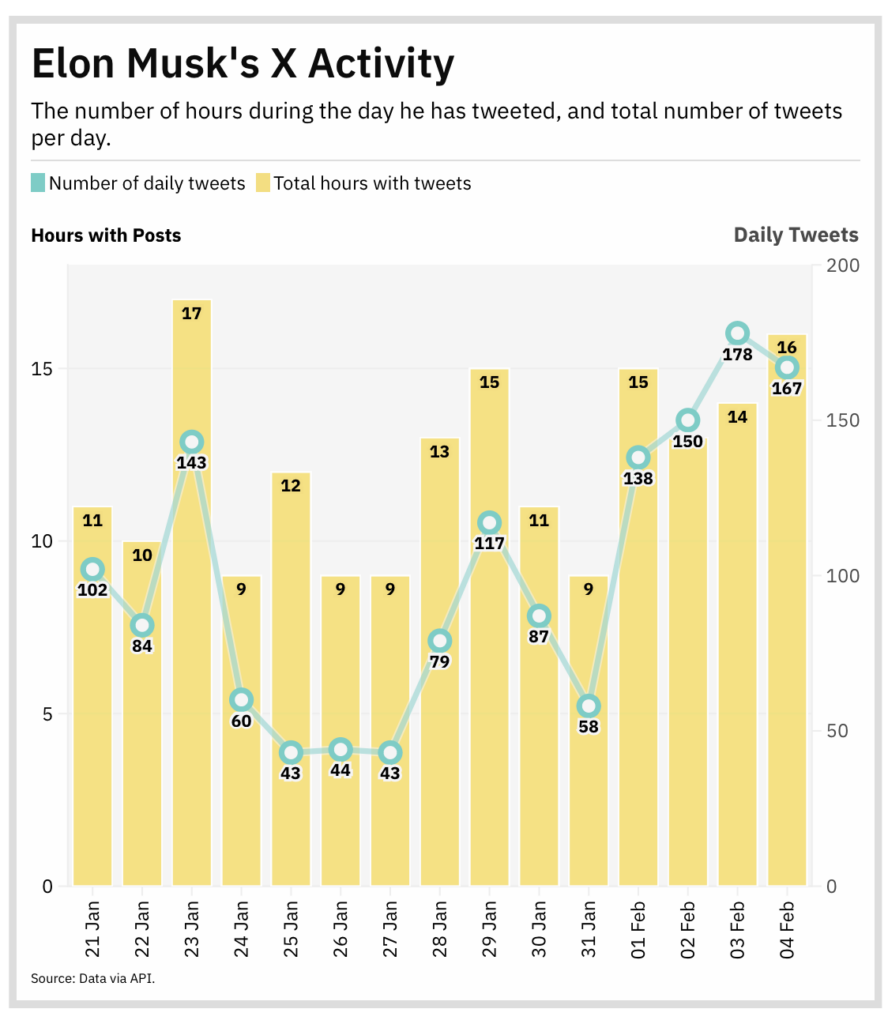Most of us in professional services wrestle with a fundamental question: How often should we post on social media? Once a week? Daily? More? This isn’t Facebook in 2010, where engagement was easy, and oversharing was the norm.
But if you want attention, look at what the richest man in the world is doing. Right now.
How do you get attention? Relentless posting. Maybe.
Elon Musk—love him or loathe him—has mastered the art of staying relevant. A recent report on his Trump-era tweets (RTÉ) shows that Musk doesn’t just tweet for the sake of it.
His posts are strategic, controversial, and relentless. In just two weeks, he tweeted more than most people do in a lifetime. This sheer volume of content keeps him at the forefront of public discourse, shaping narratives and staying top of mind for millions.
- Elon Musk’s social media activity during his first two weeks overseeing US federal employee efficiency was extraordinarily high. Data from X, the platform he owns, reveals that he posted nearly 100 tweets per day on average between 21 January and 4 February, totaling 1,494 posts.
- His peak activity occurred on 3 February, when he posted an astonishing 178 times. Each day, Musk was active across at least nine different hours, often surpassing that figure.
- His most intense tweeting session happened on 2 February between 3 AM and 4 AM EST in Washington DC, when he tweeted 49 times in just one hour—an average of once every 80 seconds. This level of activity underscores his relentless engagement with the platform and its audience.

So, What’s the Right Frequency for You?
1. More than Once a Week
If you’re only posting once a week, you might as well be whispering in a storm. Professional audiences are bombarded with content daily. If you’re not showing up regularly, you’re forgotten.
2. Daily Can Work—If Done Right
Posting daily is effective if your content is engaging, insightful, and varied. It’s not about spamming; it’s about providing value. Think industry insights, case studies, expert commentary, and even the occasional behind-the-scenes look at your business.
3. Quality Over Quantity (But Quantity Still Matters)
One high-quality post per week won’t cut it in a crowded feed. Ideally, you want to be posting at least 3-5 times a week, mixing thought leadership with lighter, engagement-driven content.
What This Means for M&A and Professional Services
M&A is a relationship-driven business. Your next deal might not come from a cold LinkedIn message but from someone who has seen your posts consistently over time and trusts your expertise. Social media is a credibility engine.
Please don’t make it about yourself.
Many people get nervous when considering regular social media posting. Typically it’s because they are visualising themselves at the core of the messaging. But if you focus on the person you are trying help or assist, posting becomes easier because you focus on the value you are providing them.
Instead of asking, How often should I post? How can I help my customer? That one person who needs help will read my post and is very unlikely to respond to the post. That’s the type of person that needs your content.
Actionable Steps to Get More Attention
- Post at least three times a week – insights, industry trends, and thought leadership.
- Engage with others – don’t just post; comment, share, and start discussions.
- Be human – personal perspectives and storytelling outperform generic corporate updates.
- Test and adjust – track what works and refine your approach.
Musk’s approach might not suit everyone, but the principle stands: visibility matters. If you want attention in a crowded digital world, you have to earn it. If Musk can tweet thousands of times in a short period to dominate attention, what’s stopping you from posting a few times a week?
If the wealthiest man in the world has to post more than 100 times a day…..
Are you posting enough?




